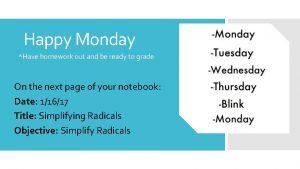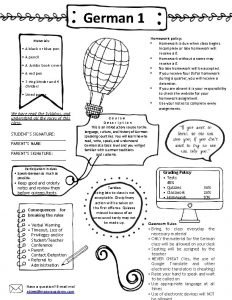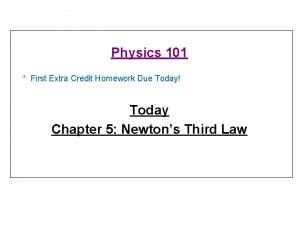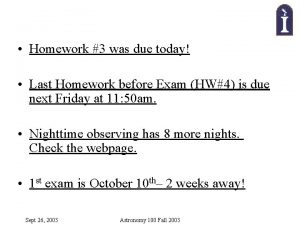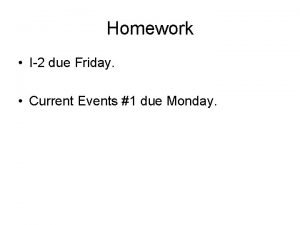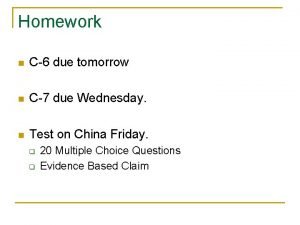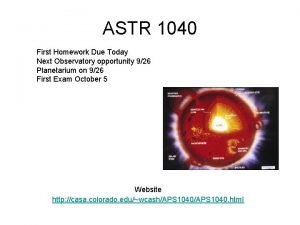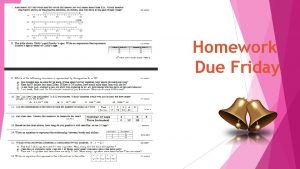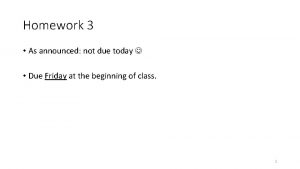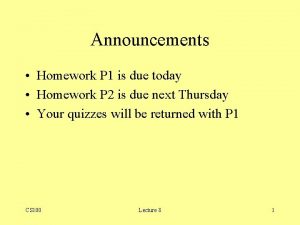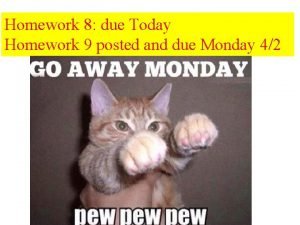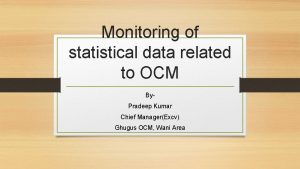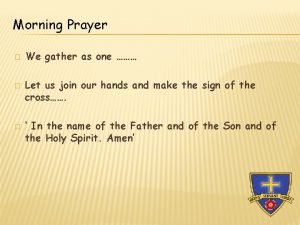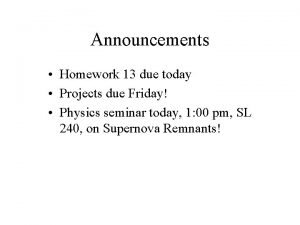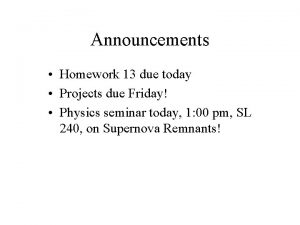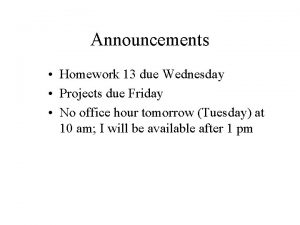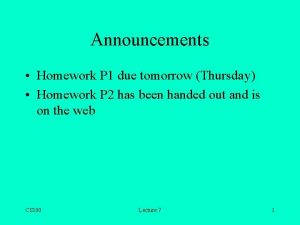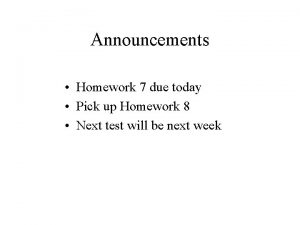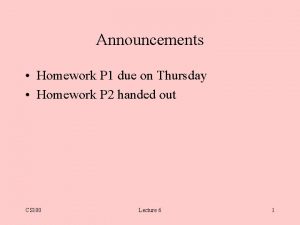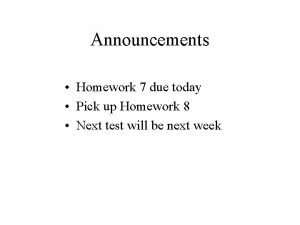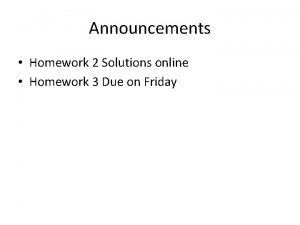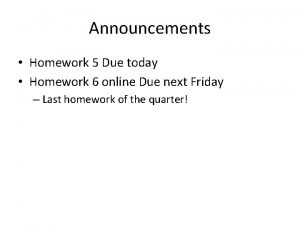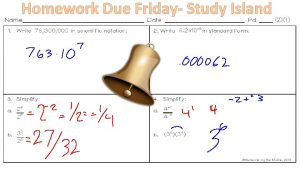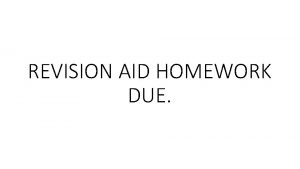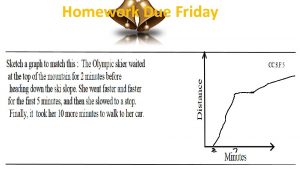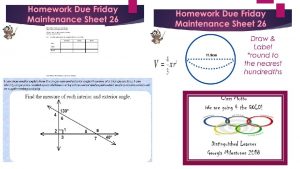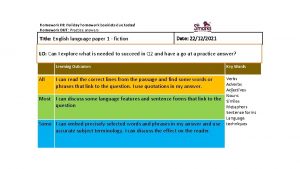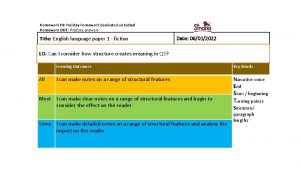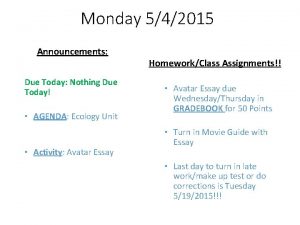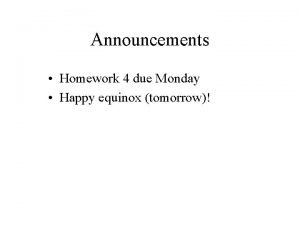Announcements Homework 8 due Monday 6 00 pm




























![What gets printed? 1 char values[] = { '5', 73, '3', 0 }; 2 What gets printed? 1 char values[] = { '5', 73, '3', 0 }; 2](https://slidetodoc.com/presentation_image_h/b176c088e07fa3b39a4f6ddd44ef0aa0/image-29.jpg)








- Slides: 37

Announcements • Homework #8 due Monday 6: 00 pm. – extra credit tasks are described at bottom of assignment page • Upcoming office hours: – Tomorrow: Sheng 12 -1: 30 pm, Greg 1: 30 -3 pm – Saturday: Greg 2 -4 pm – Sunday: Chris 2 -4 pm – Monday: Sheng 12 -2 pm, Chris 2 -4 pm • Please fill out the course evaluations!

Today • Preview of CIT 595 • Final course grading • Final exam stuff

CIT 595 • “Digital System Organization & Design” • • Originally very hardware focused Then some OS concepts introduced Then pretty much an OS course Now a systems programming course

What you’ll learn in CIT 595 • More C (function pointers) • C++: “C with objects” • Linux systems programming – Interacting with the operating system – Parallelism and synchronization – Inter-process communication – Networking

What to expect from CIT 595 • A lot of programming • No, seriously, a LOT • Longer, more challenging programming assignments • More application and less theory

Grading Guidelines • • • Homeworks: 50% Lab assignments: 10% Midterm exam: 15% Final exam: 25% Current weighted average: 90. 3% Projected weighted average: 86. 9% 97+ A+ 87 -90 B+ 93 -97 A 83 -87 B 90 -93 A- 80 -83 B-

Final Grading • Homework #6 should be graded by this weekend • Homeworks #7 and 8 should be graded by the final exam date (Dec 17) • Final exams should be graded by Dec 19 • Final course grades should be posted on Dec 21


Final Exam Logistics • Monday, Dec. 17, 6 -8 pm • Location: DRL A 6 • You can use your book, notes, etc. • No electronic devices! • Review session. . . when? • Sandwiches, sodas, snacks, etc. will be provided from 5 -6 pm that evening in Levine 307

Final Exam Material • Patt & Patel chapters 2 -14, 16, 18 -19 – in other words, pretty much the whole book except for chapters 1, 15, and 17 • x 86 architecture (Appendix B) • Data structures • No UNIX stuff from lab! • No computer science history! • About 25% pre-midterm stuff, 75% stuff from after the midterm

Format of the exam • Multiple-choice definitions/concepts • Short answer and problem solving – Like midterm and questions from book • Understanding C and assembly code • Modifying C and assembly code • Writing C code (around 15 -20 lines max) – no writing LC-3 from scratch!

Preparing for the exam • Documents in Blackboard: – – – study guide (list of questions from book) practice questions (and solutions) solutions to homework assignments • Form a study group • Ask questions on Piazza

Computer Numbers (Chp. 2) • Unsigned binary integers – Decimal-to-binary conversion – Hexadecimal numbers – Unsigned binary arithmetic • Signed binary integers – Sign/magnitude – Two’s complement – Overflow

Computer Numbers (cont. ) • Floating point representation • Logical operations and bit vectors • Character representation – ASCII – Unicode

Digital Logic (Chp. 3) • p-type and n-type transistors • NOT, AND, and OR gates • Sum-of-products algorithm

Combinational Logic Circuits (Chp. 3) • Adder (1 -bit, 4 -bit, n-bit) • Decoder: n inputs, 2 n outputs • Demultiplexer: 1 input, n select lines, 2 n output • Multiplexer: 2 n inputs, n select lines, 1 output

Memory (Chp. 3) • R-S Latch: depends on “state” • Gated D Latch: single bit of memory • Register: some number of Gated D Latches that form a single unit of memory

von Neumann Architecture (Chp. 4) • Memory – – address space vs. addressability MAR and MDR • Control Unit – – – fetch, decode, execute IR and PC ALU, registers

LC-3 Instruction Set Architecture (Chp. 4) • Instruction format – Opcode – Operands • Translating from assembly language to machine language • Types of instructions & what they do – ALU operations – Data movement operations – Control operations

x 86 Architecture (Appx. B) • How is it different from LC-3? – – – addressability address space number of registers size of registers number of operations size of instructions

Assembly Language (Chp. 7) • • • Symbol table Finding and fixing bugs What does this program do? How can this program be improved? Relation with higher-level language (like C) • BLKW, FILL, and STRINGZ

Traps, Interrupts, Subroutines (Chp. 8 -9) • How are subroutines called? How does the program know where to go back to? • How do traps work? How does the program know where to go back to? • How do interrupts work? How is the state saved? What happens when the handler finishes? • Traps: GETC, IN, OUT, PUTS, HALT

Memory and the Stack (Chp. 10) • What is the stack used for? • What is the stack pointer? Frame pointer? • What values go on the stack when a function is called?

C Basics (Chp. 11) • Compilation process – Preprocessor – Compiler – Linker • Anatomy of a C program • Primitive Datatypes

Variables and Operators (Chp. 12) • • • Legal variable names Mathematical operators Assignment shortcuts Scope printf and scanf

Loops & Conditionals (Chp. 13) • Logical operators • Comparison operators • True & False • if, if/else • while, do/while, for

Functions (Chp. 14) • Function declarations/prototypes • Input & Output • Call-by-reference vs. Call-by-value

Arrays & Strings (Chp. 16) • Declaring and initializing arrays • Indexing arrays • Declaring strings • Null-terminated strings • String functions – strlen, strcmp, strcat, strcpy
![What gets printed 1 char values 5 73 3 0 2 What gets printed? 1 char values[] = { '5', 73, '3', 0 }; 2](https://slidetodoc.com/presentation_image_h/b176c088e07fa3b39a4f6ddd44ef0aa0/image-29.jpg)
What gets printed? 1 char values[] = { '5', 73, '3', 0 }; 2 int x = values[values[3]]values[2]]; 3 int y = (char)x - '0'; 4 int z = values[y]; 5 if (z & values[z]) z = ++z; 6 printf(“z is: %dn”, z);

1 int one(int a, int b) { 2 int k, t; 3 k = a - b; 4 t = a + b + 1; 5 if (k % 2 == 0) return t; 6 else return 0; 7 } 8 9 int two(int x, int y) { 10 int m; 11 return m + x + y; 12 } 13 14 main() { 15 int result = two(5, one(4, 3)); 16 printf(“result is %dn”, result); 17 }

Pointers (Chp. 16) • pointer syntax • passing pointers as function parameters • pointers vs. arrays vs. strings

1 2 3 4 5 6 7 8 9 10 int apple; int *ptr; int **ind; ind = &ptr; *ind = &apple; **ind = 123; ind++; *ptr++; apple++; printf(“%d %d %d”, ind, ptr, apple);

Structs (Chp. 19) • defining a struct • typedef • pointers to structs

Data Structures • • • Linked List Stack Queue Binary Search Tree Hashtable • Concepts (how they work) • Implementation in C

Final Exam Logistics • Monday, Dec. 17, 6 -8 pm • Location: DRL A 6 • You can use your book, notes, etc. • No electronic devices! • Sandwiches, sodas, snacks, etc. will be provided from 5 -6 pm that evening in Levine 307

Any questions?

The end. (thanks!)
 You spent 3/2 hours on homework last night
You spent 3/2 hours on homework last night Homework for monday
Homework for monday Square root of 150 simplified
Square root of 150 simplified Pvu market cap
Pvu market cap Potentiial
Potentiial /r/announcements
/r/announcements General announcements
General announcements David ritthaler
David ritthaler What did beatty discover when he hit montag
What did beatty discover when he hit montag Homework oh homework i hate you you stink
Homework oh homework i hate you you stink The zebras cried when the wise old elephant died
The zebras cried when the wise old elephant died Parts of a poem
Parts of a poem Homework oh homework
Homework oh homework Jack prelutsky homework oh homework
Jack prelutsky homework oh homework Alitteration definition
Alitteration definition Homework is due
Homework is due Folk culture and popular culture venn diagram
Folk culture and popular culture venn diagram Homework due today
Homework due today 3 weeks from today
3 weeks from today Homework is due on friday
Homework is due on friday Ilegalism
Ilegalism Astr
Astr Homework is due on friday
Homework is due on friday Homework due today
Homework due today Homework due today
Homework due today Black cat analogy
Black cat analogy Principio di conservazione della quantità di moto
Principio di conservazione della quantità di moto Figura con 4 lati
Figura con 4 lati Substantive vs procedural due process
Substantive vs procedural due process Slidetodoc.com
Slidetodoc.com Easter in poland
Easter in poland Hemmper
Hemmper Monday done right meaning
Monday done right meaning Happy december good morning
Happy december good morning Morning prayer at school
Morning prayer at school Happy monday welcome back
Happy monday welcome back Monday my favorite day
Monday my favorite day Monday bell ringer
Monday bell ringer


